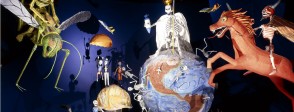The first three activities aim to use the object to provide context for exploring specific aspects of the second half of the AD 1900s.
Look at the photographs in For the classroom of the individual figures of War, Pestilence, Famine from The Atomic Apocalypse. Discuss with students what they think they show and whether they are intended to be taken seriously. Show the students the image of the full assemblage and ask them again whether they think there is some serious message behind the sculptures. Ask students to try to pick out individual scenes from the assemblage and comment on what they think they show.
You could also start by selecting some of the objects from the huge British Museum collection of Day of the Dead artefacts – see link in For the classroom. You should find sugar skulls, skeleton bride and groom, skeleton hairdressers, musicians and builders, as well as papercuts. Discuss the tone of these objects and introduce the students to the Day of the Dead. Discuss the concept of satire, using examples students are familiar with. Move from there to consideration of The Atomic Apocalypse.
After identifying the sculptures as satirical, discuss what the title means. The students should be able to pick out that ‘atomic’ refers to nuclear issues in some way, but may need help with the concept of an apocalypse. What other world dangers apart from war can students think of - use the individual figures of Pestilence and Famine either to confirm or prompt their ideas. Use the prints in For the classroom to develop the notion of an apocalypse and to relate it to religious ideas – some students may be able to draw on their own familiarity with religion to support this.
Discussion and exploration of the object and the concept of an apocalypse should provide a basis for identifying historical events and issues and developing enquiries.
The threat of nuclear war is a good starting point for helping students to understand the increased scale of anxieties in this period and for moving into enquiries into other issues. Take the example of the Cuban Missile Crisis and investigate it in detail bringing out its impact on ordinary people. In addition to war, introduce the issues of epidemics, environmental damage and famine and divide the class to conduct enquiries into how each developed over the period from 1945 to 2000. Students might consider specific events, what the factors were that brought each issue to prominence at different times, how governments responded, what the impact was on the public and how activists responded. How different was the world in 2000 from what it was in 1945?
Throughout history, disasters have been seen as manifestations of divine wrath or judgement. Watch the You Tube clip about HIV/AIDS and draw students’ attention to the caption. Mediate the New Scientist article in More information and compare modern response to AIDS and Ebola with the biblical notion of apocalypse or punishment. Consider why advances in scientific understanding and knowledge are not always reflected in the response to epidemics and disasters.
A recent theory about the origins of HIV, its transmission from apes and monkeys to humans and subsequent rapid spread is that this was made possible by changes in social conditions brought about by European colonialism. Discuss with the class whether they feel this is a viable theory, and if so what responsibility should be taken by the old colonial powers. This can lead into a wider discussion of post-colonialism and the West’s current role in Africa. To what extent should the results of historical actions continue to impose obligations on the descendants of those responsible for them?
Many issues and events that in previous centuries would have been considered local problems are now global issues. Discuss what the principal factors are that have caused this, for example, mass transport, the global market place, migration and immigration, refugees, political alliances, increased powers and the reach of technologies. To what extent is this global concern solely driven by economic and political interest and to what extent a wider expression of fundamental human compassion? How comfortably do these two ideas co-exist? How much has the new global economy actually been the cause of crises and disasters?
Look at the objects in A bigger picture and analyse each one for what its message is, how its message is communicated and who its target audience is. Select one or more global issues that came to fore after 1945 and track the development of political campaigning around the issue. Why was a need felt for popular activism? How did the campaign develop? What was the relationship between local action and large scale activity? What were the major setbacks or successes for the campaign and by AD 2000 what progress had been made? Suggest that students select five badges related to the issue and use them to structure their presentation – see the collection search in For the classroom or use the internet.


